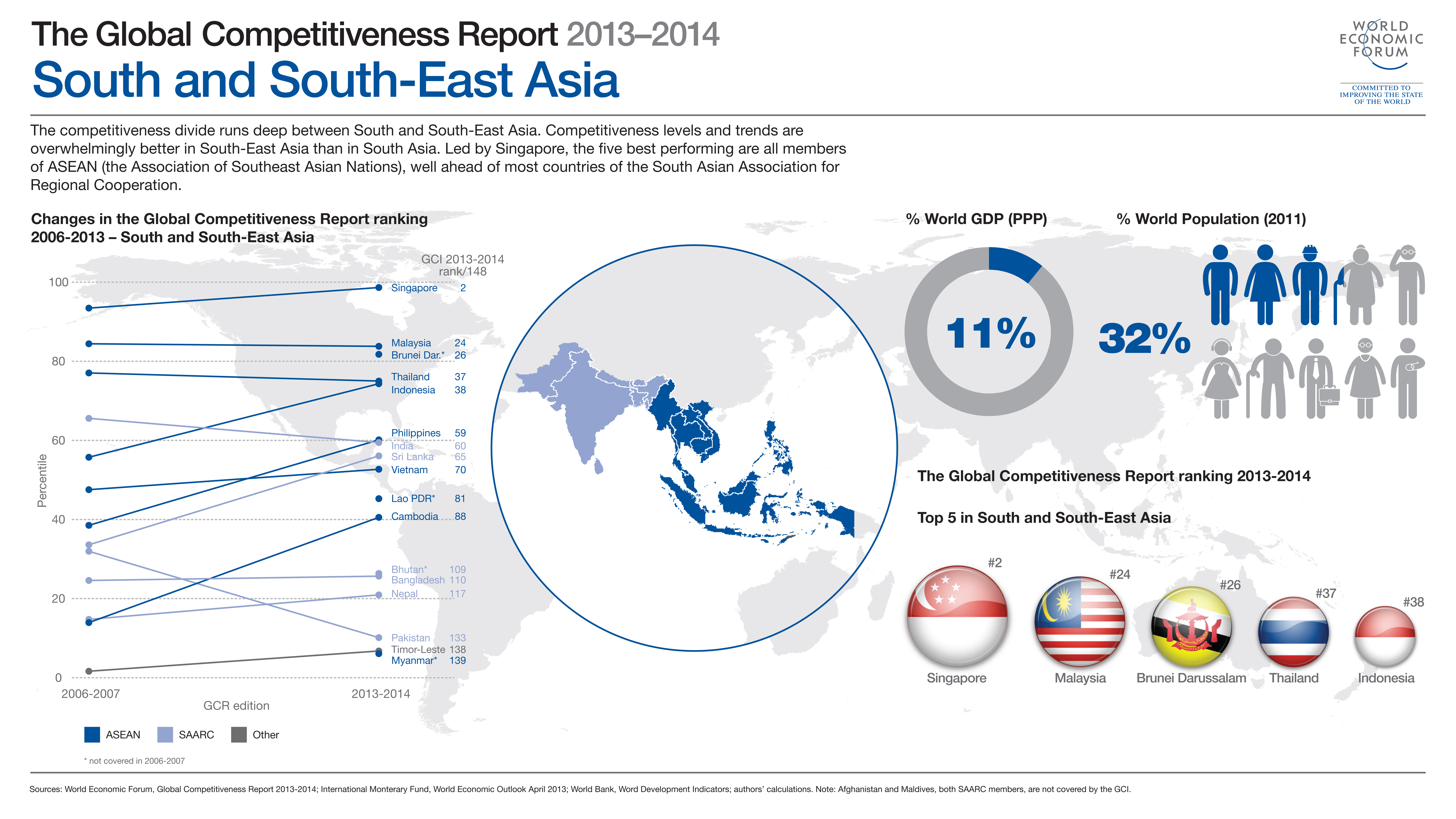[caption id="" align="aligncenter" width="622"]
 The Global Competitiveness Report 2013-2014 South East Asia[/caption]
The Global Competitiveness Report 2013-2014 South East Asia[/caption]World Economic Forum‘s Global Competitiveness Report 2013-2014 displays very similar rankings to those of the previous year. Just as it also did in the 2 previous years, Taiwan has climbed to the 12th position. According to the report, Taiwan‘s “performance has been very stable and consistently strong over the past five years. Notable strengths include the capacity of Taiwanese businesses to innovate (8th), its highly efficient goods markets (7th), and its world-class primary education (9th) and higher education (11th). In order to enhance its competitiveness, Taiwan will need to further strengthen its institutional framework (26th), whose quality is undermined by some inefficiency within the government (28th) and various forms of corruption (30th), and will also need to address some inefficiencies and rigidities in its labour market (33rd)” (from http://www3.weforum.org/docs/GCR2013-14/GCR_CountryHighlights_2013-2014.pdf).
In an East Asian context, Taiwan is behind Singapore, Japan and Hong Kong, and in front of Malaysia, South Korea and China. In the global ranking, Switzerland and Singapore remain at the top 2 positions, whereas Hong Kong moves up from position 9th to 7th and Japan improves one place, from 10th to 9, respectively. South Korea worsens its position from 19 to 25, whereas Malaysia moves upwards from position 25th to 24th and China remains in position 29th. Spain‘s position has improved from 36th to 35th during the last year.
According to the report, Singapore “ranks 2nd overall for the third consecutive year, owing to an outstanding performance across all the dimensions of the GCI. Again this year, it is the only economy to feature in the top 3 of seven out of the 12 pillars of the GCI; it also appears in the top 10 of two others. It dominates the goods market efficiency pillar and the labour market efficiency pillar, and places 2nd in the financial market development pillar. Furthermore, the city-state boasts one of the world’s best institutional frameworks (3rd), even though it loses the top spot to Finland in the related pillar. Singapore also possesses world-class infrastructure (2nd), with excellent roads, ports, and air transport facilities. Its economy can also rely on a sound macroeconomic environment and fiscal management (18th)—the budget surplus amounted to 5.7 percent of GDP in 2012. Singapore’s competitiveness is further enhanced by its strong focus on education, which has translated into a steady improvement of its ranking in the higher education and training pillar, where it comes in 2nd, behind Finland. Singapore’s private sector is also becoming increasingly sophisticated (17th) and more innovative (9th), although room for improvement exists in both areas, which are the keys to Singapore’s future prosperity” (from http://www3.weforum.org/docs/GCR2013-14/GCR_CountryHighlights_2013-2014.pdf).
Hong Kong "further consolidates its position among the 10 most competitive economies, advancing a further two places to 7th, thanks to a consistently strong performance. In particular, Hong Kong tops the infrastructure pillar for the fourth consecutive edition, reflecting the outstanding quality of its facilities across all modes of transportation. It also dominates the financial market development pillar, owing to the high level of efficiency, trustworthiness, and stability of the system. As in the case of Singapore, the dynamism and efficiency of Hong Kong’s goods market (2nd) and labour market (3rd) further contribute to its excellent overall positioning. In order to enhance its competitiveness, Hong Kong must improve on higher education (22nd) and innovation (23rd, up three). In the latter category, the quality of research institutions (31st) and the limited availability of scientists and engineers (32nd) remain the two key issues to be addressed" (from http://www3.weforum.org/docs/GCR2013-14/GCR_CountryHighlights_2013-2014.pdf).
And China, “remains stable at 29th position this year. The country posts small gains in certain areas of the Index but loses ground in others, resulting in an overall performance virtually unchanged since last year. China leads the BRICS economies by a wide margin, well ahead of South Africa (53rd), Brazil (56th), India (60th), and Russia (64th). The Chinese institutional framework is improving slightly (47th), but weaknesses—including corruption (68th), security issues (75th), and low levels of accountability (82nd) and ethical standards (54th) among businesses—remain. In addition, problems endure in those areas that are becoming increasingly important for China as it becomes wealthier and can no longer rely on cheap labour: its financial market (54th) is undermined by the relative fragility of the banking sector; technological adoption by firms (86th) and by the population at large (79th) remains very low; and the efficiency of its goods market (61st) is seriously undermined by various barriers to entry and investment rules, which greatly limit competition. On a more positive note, China’s macroeconomic situation remains favorable (10th). Inflation was back down to below 3 percent in 2012 (from 5.4 percent the previous year), the budget deficit is moderate, China’s public debt-to-GDP ratio at 22.9 percent is among the lowest in the world, and the gross savings rate represents a staggering 50 percent of GDP. However, this rate is probably too high in light of the need for China to rebalance its economy away from investment and toward more consumption. Although China receives good marks in health and basic education (40th), the assessment is more negative when it comes to higher education (70th) because of China’s low tertiary education enrollment, the average quality of teaching, and an apparent disconnect between educational content and business needs (54th). Finally, China’s innovation capacity has been improving recently, but much remains done for it to become an innovation powerhouse" (from http://www3.weforum.org/docs/GCR2013-14/GCR_CountryHighlights_2013-2014.pdf).
The full report can be downloaded as pdf from the World Economic Forum website.
No comments:
Post a Comment
Note: Only a member of this blog may post a comment.